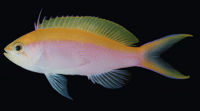Difference between revisions of "Pseudanthias bartlettorum"
From The Aquarium Wiki
m |
|||
| Line 35: | Line 35: | ||
|max_water_hardness=12 | |max_water_hardness=12 | ||
}} | }} | ||
| − | |||
| − | |||
| − | |||
| − | + | == Sexing == | |
| − | + | :Anthias species all share the trait of being hermaphroditic. If a dominant male perishes, the largest female of the group will often morph to take its place. Males colouration tends to be more vivid than females. | |
| − | + | ||
| − | + | ||
| − | + | == Tank compatibility == | |
| − | + | :Prefers to be in large groups of it's own species. Generally peaceful towards other tank mates and is reef-safe. | |
| + | |||
| + | |||
| + | |||
| + | == Diet == | ||
| + | :This Anthia should be fed foods such as [[mysis shrimp]], vitamin-enriched [[brine shrimp]], frozen foods and other meaty items for zooplankton feeders. | ||
| + | |||
| + | |||
| + | == Feeding regime == | ||
| + | :Feed these fish small quantities several times a day. | ||
| + | |||
| + | |||
| + | == Environment specifics == | ||
| + | :Keep in a rocky environment with overhangs and hiding places. | ||
| + | |||
| + | |||
| + | == Behaviour == | ||
| + | :A generally peaceful fish that appreciates company of its own kind and will spend some time hiding under overhangs and other hiding places. | ||
| + | |||
| + | |||
| + | == Identification == | ||
| + | :An attractive fish with a forked caudal tail. Males have a more intense colouration with a violet body and yellow running along the back through the upper caudal lobe. The females tend to be lavender in colour with a yellow back and caudal fin. | ||
| + | |||
| + | |||
{{Categories | {{Categories | ||
|Category=Fish, Fish (Saltwater), Anthias | |Category=Fish, Fish (Saltwater), Anthias | ||
Latest revision as of 03:09, 13 December 2017
Bartlett's Anthias
Pseudanthias bartlettorum
208 Litres (55 US G.)
7.6-10.2cm (3-4 ")
8.0 - 8.5
22.2-25.6°C (72 -78 °F)
8-12 °d
1:3 M:F
3-5 years
Family
Serranidae
Contents
Additional names
- Bartlett's Anthias, Bartlett's Fairy Bass
Sexing[edit]
- Anthias species all share the trait of being hermaphroditic. If a dominant male perishes, the largest female of the group will often morph to take its place. Males colouration tends to be more vivid than females.
Tank compatibility[edit]
- Prefers to be in large groups of it's own species. Generally peaceful towards other tank mates and is reef-safe.
Diet[edit]
- This Anthia should be fed foods such as mysis shrimp, vitamin-enriched brine shrimp, frozen foods and other meaty items for zooplankton feeders.
Feeding regime[edit]
- Feed these fish small quantities several times a day.
Environment specifics[edit]
- Keep in a rocky environment with overhangs and hiding places.
Behaviour[edit]
- A generally peaceful fish that appreciates company of its own kind and will spend some time hiding under overhangs and other hiding places.
Identification[edit]
- An attractive fish with a forked caudal tail. Males have a more intense colouration with a violet body and yellow running along the back through the upper caudal lobe. The females tend to be lavender in colour with a yellow back and caudal fin.
Pictures[edit]
External links[edit]
- Fishbase (Mirrors:
 )
)

